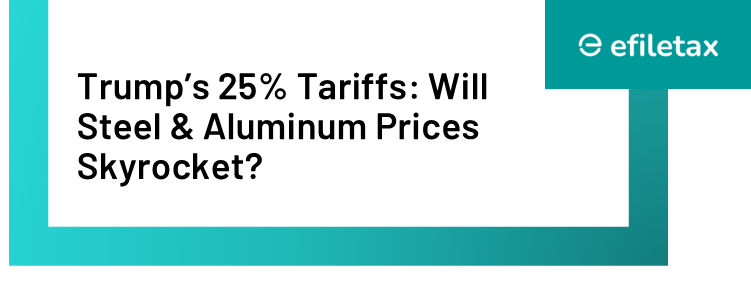
Trump’s Tariff Move: What’s Changing?
Starting February 10, 2025, former U.S. President Donald Trump has announced a 25% tariff on all steel and aluminum imports. This decision signals a shift toward protectionist trade policies aimed at shielding domestic industries but comes with global consequences.
Unlike previous tariff rounds where countries like Canada and Mexico were granted exemptions, this time, no country is exempted—affecting key exporters across Europe, Asia, and South America.
Global Impact: How Countries are Reacting
1. Canada & Mexico 🇨🇦🇲🇽
- Biggest suppliers of steel and aluminum to the U.S.
- Previously exempted under USMCA, but now face trade challenges.
- Likely to retaliate with tariffs on American exports, impacting auto & manufacturing sectors.
2. European Union (EU) & UK 🇪🇺🇬🇧
- Major exporters of high-grade steel and specialty aluminum.
- Potential legal action at the WTO citing unfair trade practices.
- Retaliatory tariffs could target U.S. tech and agriculture exports.
3. Australia & Japan 🇦🇺🇯🇵
- Australia’s mining sector faces heavy losses as iron ore and aluminum shipments become expensive.
- Japan, a key supplier of auto-grade steel, may seek bilateral trade adjustments.
4. China & India 🇨🇳🇮🇳
- China already faces steel tariffs from the U.S. but could shift supply chains, leading to global pricing changes.
- India, a growing steel exporter, might negotiate alternative trade agreements to mitigate losses.
Economic Impact: Rising Costs & Inflation Risks
1. Higher Costs for U.S. Businesses
- Automobile, construction, and manufacturing industries depend on imported steel & aluminum.
- Increased costs could be passed to consumers, leading to higher prices for cars, appliances, and infrastructure projects.
2. Market Reactions 📉
- Stock markets, especially in Asia and Australia, have already reacted negatively.
- U.S. steel stocks surged, but companies relying on imported metals saw sharp declines.
- The U.S. dollar showed mixed movement, with investors uncertain about long-term effects.
3. Inflation & Consumer Spending
- Increased tariffs often lead to inflationary pressure, raising production costs.
- Higher prices on everyday goods could impact consumer sentiment and spending.
Trade Laws & Legal Challenges
1. WTO Dispute Likely 🌍⚖️
- The European Union and other affected countries are expected to challenge the tariffs at the World Trade Organization (WTO).
- Similar cases were filed during Trump’s first term, where WTO ruled against some tariffs.
2. Section 232 of U.S. Trade Law
- Trump is using Section 232 of the Trade Expansion Act of 1962, claiming national security concerns.
- Previous WTO rulings have criticized such justifications, making a legal battle likely.
3. Retaliation from Trading Partners
- Countries may impose counter-tariffs on American goods, affecting industries like:
- Agriculture 🥩 (U.S. soybean & meat exports)
- Technology 📱 (Tariffs on American electronics)
- Automobiles 🚗 (U.S. car exports facing higher duties)
Political & Diplomatic Consequences
1. Impact on U.S.-India Relations 🇮🇳🤝🇺🇸
- PM Narendra Modi’s upcoming U.S. visit might focus on trade negotiations.
- India may seek exemptions or preferential trade terms.
- Talks on expanding the Indo-Pacific trade corridor may gain urgency.
2. U.S. Elections & Business Backlash
- Trump’s move aligns with his “America First” policy, appealing to domestic manufacturers.
- However, business lobbies and consumer advocacy groups warn of higher costs and job losses.
Conclusion: What to Watch Next?
- Market reactions: Will stock prices stabilize or decline further?
- Retaliatory tariffs: Which countries will impose counter-measures?
- WTO response: Will legal action block the tariffs?
- Political fallout: How will this impact U.S. diplomatic ties and election campaigns?
The coming weeks will be critical in shaping the future of global trade. Stay tuned for updates as nations respond to this major policy shift.
Key Takeaways
| 🔍 Factor | 🏭 Impact |
|---|---|
| Steel & Aluminum Tariffs | 25% tariff on all imports, affecting major exporters. |
| Key Affected Nations | Canada, Mexico, EU, Australia, Japan, China, India. |
| Industry Impact | Auto, construction, and manufacturing costs rise. |
| Stock Market Reaction | Asian markets fall, U.S. steel stocks rise. |
| Inflation Risk | Higher prices for consumers, potential economic slowdown. |
| Political Moves | WTO dispute, Modi’s visit, and U.S. election impact. |